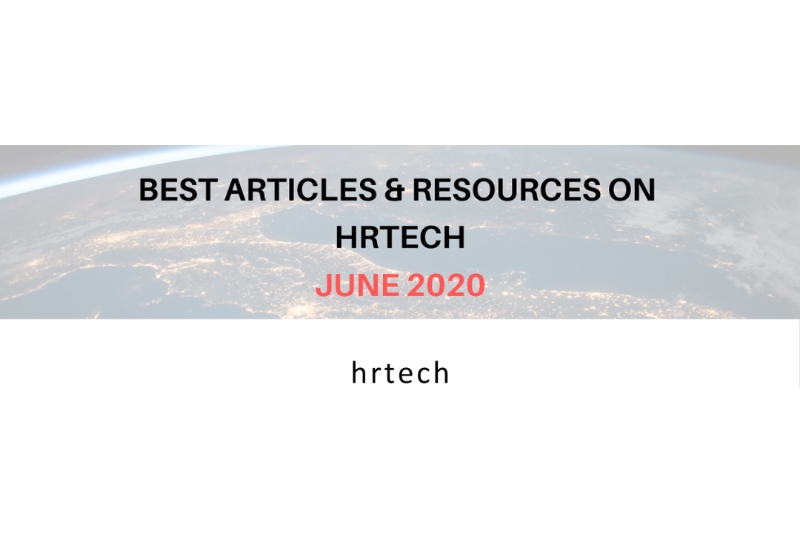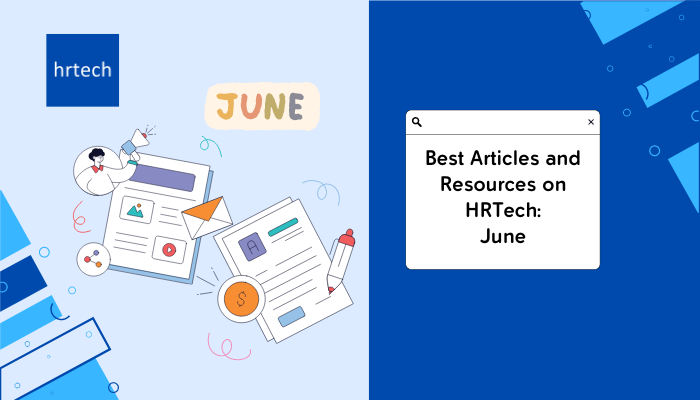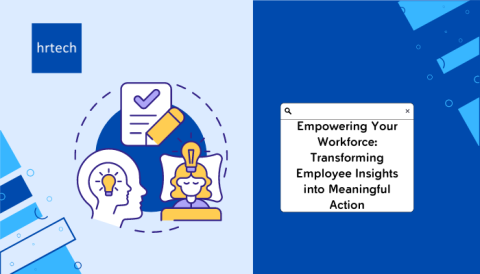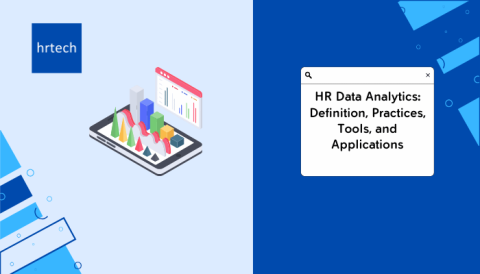Best Articles and Resources in #HRTech space in June 2020

I. How Can HR Become More Data-Driven and Digital?
BY IAN BAILIE(myHRFuture) and JOHN SUMSER(HR Examiner)
The blog summarizes some of the key themes present in the discussion between Ian Bailie (myHRFuture) and John Sumser (HR Examiner) about the changing nature of learning and how can HR become more data driven and digital to deliver the greatest business value.
The digital age has changed, the way the work is done, and the workplace itself, to be able to comprehend and analyze this workplace data which can be of tremendous value to organisations.
As a result, there is an increasing need for HR professionals to become digitally and numerically literate – to acquire the skills necessary to process, produce and leverage digital information.
Research carried out by Insight222 in early 2019 identified six key skills that HR professionals felt they needed to build to be able to effectively support their organisations through this period of transformation. Ian listed them as
- People Analytics
- Workforce planning
- Digital HR and HR Technology
- Design Thinking
- Consulting and influencing
- Stakeholder management
Top skills required by HR Professionals , Source : myHRFuture
While every HR professional does not need to be data scientist, there is a level of knowledge around data, statistics and being able to really interpret data, translate it into insights and have a data driven conversation with a leader, that is absolutely critical for the future of HR. As a function, HR must become more evidence based and in order to do that, the HR professionals that make up that function must be capable of having such conversations with the business and leaders, thus there is a need to build this digital savviness that has not always been required of HR professionals in the past. HR also needs to understand the digital impact to the business.
Read detailed blog and watch the interview here.
II. Guess Who’s Disrupting HR Tech Now? Facebook. Yes, it’s Facebook.
BY JOSH BERSIN , Joshbersin.com
Josh Bersin, in his article, digs deep into Workplace by Facebook, which he says could be the next gen HR tool for collaboration with set of channels, groups, chat interface, place to post documents, articles and videos. While there are multiple collaboration tools in the market like Microsoft Teams, Slack, SharePoint, Yammer, WebEx and Zoom, Workplace is particularly positioned as a HR tool and ideal for deskless or frontend workers. If you’re a retail worker, a mobile employee, a delivery driver, or any other type of front-line employee (we are all “front line” at some point in our jobs), Workplace is a single place to go for everything
Workplace has proven to be swiss army knife when it comes to applications of all sorts. It also provides customizable chatbot platforms, ability to build custom workflows to improve myriad of new employee experiences and do more with the backend with simplicity than other HR systems do. The platform also supports plugins for employee surveys, performance management, and many other emerging areas.
In the era of the Pandemic, leaders and employees need to talk all the time and executives at one of the customers of Workplace could send top-down messages, share posts and communications within their organizations just like they would do on the Internet. The result is a real-time communication culture, and the hierarchy is starting to break down.
Everyone is on the same platform; “all-employee” meetings are now conducted on Workplace; and as stress and anxiety have increased from the virus, HR now does regular polls to figure out how to make work easier.
Workplace is in the right place at the right time when it comes to help support employees. Read more here.
III. How Cognitive Technologies Can Help Managers During the COVID-19 Crisis
BY FREDERIC LALUYAUX, MIT Sloan Management Review
A product of the artificial intelligence field, cognitive technologies have been in development for decades. One of the most important of these technologies is cognitive automation where AI processes the information continuously, draws conclusions, and sends back key information. Cognitive automation offers tremendous potential for managers.
Since the sudden emergence of COVID-19, just about every aspect of business has become unstable and unpredictable. With cognitive automation, businesses are better able to make this happen. Often this results in a lag that prevents businesses from having what consumers are looking for at the ready. With cognitive automation, this lag can quickly disappear.
For example, businesses can be alerted instantly if there’ s increased demand in Cleveland and decreased demand in San Francisco and reroute shipments instantly. There’s a powerful business incentive, in addition to a purely empathy-based one, for managers to focus on ensuring that their workers feel safe. The last thing managers should be grappling with during the pandemic is a slate of tasks that machines could be taking care of. Cognitive Technologies can help us relieve the pressure on our teams as fast as possible by optimizing our tasks, so we have time for things that matter more.
Read more about it in the article here.
IV. Using HR Tech in the times of COVID-19
BY Prof (Dr.) SARIT PRAVA DAS, People Matters
The current crisis has compelled the organizations to switch to technology-based disruptions in the traditional work settings. At one end HR managers are suggesting employees the suitable massive open online course on platforms like Coursera and Edx for Learning & Development while at the other end, End-to-end encrypted software are calculating Compensation and Benefits for the employees. Transitioning traditional HR systems into tech-based HR demands large investment in IT infrastructure. The market is full of technology providers, the HR managers must select reliable, efficient, and user-friendly technology solutions. Seeking clarity on various HR processes is the prerequisite for infusing technology in the HR department. Keeping in view the data security, CHROs are investing in technology for HR processes like hiring, talent management, performance evaluation, employee development, CTC calculation, etc.
The ultimate user of this HR technology is the employee. Some companies are proactively training the employees on future preparedness on handling technology with responsibility and effectiveness. In this transition phase, to increase the adoption of technology investments, the leaders must incentivize those who use technology more and focus on bridging the gap for those who are the first-time users. This will help build better experiences and bring the best return on investment.
Read more about it in the article here.
V. The Role of ONA in the Future of Work: Enabling Distributed Flat Hierarchies
BY FRANCISCO MARIN (CEO and Co-Founder Cognitive Talent Solutions)
COVID-19 pandemic has brought about chaos and opportunities acting as a catalyst of digital transformation and iconic companies like Twitter announced that it will be allowing some of its workforce to continue working from home forever.
Francisco Marin Mayer, CEO of Cognitive Talent solutions shares given that COVID-19 is accelerating wide scale business transformation, organization with the highest possible degree of digitalization and decentralization least hierarchy would look like a distributed flat hierarchy. A distributed flat hierarchy, which is neither new nor untested, is an organizational structure with few or no levels of middle management between staff and executives and is used in organizations are looking for insights to help their leaders manage networks of staff in networked environments.
He shares that use of ONA in such networked environments could also enable organizations to work with fully distributed teams in a more effective and efficient manner by 1) monitoring productivity of employees working remotely, 2) accelerating adoption of new strategies, policies and procedures by leveraging informal leaders as early adopters, 3) proactively assessing and mitigating employee burnout, 4) enhancing remote employee onboarding and 5) preventing employee isolation during remote working.
Visualization of an informal network through ONA. Source: Cognitive Talent Solutions
To understand more about role of ONA in the future work, read here.
VI. Artificial Intelligence & Virtual Reality – Emerging Wave
BY DAKSHDEEP SINGH, PRIYANKA SHARMA, ET HRWorld.com
With the evolution of technology into daily life, we now live in a world of experience-driven global connectivity. AI and VR which used to be technology buzzwords are now used to augment the day-to-day operational tasks for work, worker, and workplace instead usual perception of taking away jobs.
There is a paradigm shift in the work, worker, and workplace itself. In the working environment VR is giving boost to the remote working trend , collaboration is coming at the forefront of all employee experiences ; VR,AR and AI are increasingly being used to enhance employee experience through personalization or upskilling them by sharpening their learning curves; and the workplace itself is being transformed by the use of AI and VR by simulating the hiring process and inducting new joiners to settle in via AI enabled chatbots by making the new joiners virtual tours and making them comfortable in the new environment .
Read the full article on how AI and its uses are becoming a part of the work, worker and workplace here.
VII. CASE STUDY: Empowering HR By Integrating Technology
BY NAYELA MULLA (Head – Human Resources, InterMiles), BWPeople.in
The solid emergence of the ‘work-from-home’ model has been one of the notable revelations in the aftermath of the Covid-19 pandemic. The seamless adaptation to work-from-home by a large section of the formal workforce across sectors is a testimony to the efficiency and effectiveness of the concept.
As the world of work changes, the workplace also needs to change. The changing nature of work necessitates that workplaces are increasingly geared for flexibility, collaboration, and connectivity. Employees now primarily use digital technologies and devices to carry out knowledge-intensive work; universally accessible multi-media communication and document management systems have become essential collaboration tools.
With the current situation expediting the adoption of HR Tech, when adoption earlier took weeks or months is now only a matter of days.
The effectiveness of a new economy workplace, in this new era of remote working, hinges on two prime factors –the availability of digital devices and additional tools and software that promote collaboration and engagement. Forward-looking organizations can use engagement and collaboration platforms to set up different channels for learning, employee engagement, wellness, etc., addressing all metrics of employee productivity and welfare. Integrating technology is yielding rich dividends not only in terms of enhancing employee engagement and productivity but also in the sphere of HRM, through the employee life cycle – right from the first interview and on-boarding to separation and final settlement. From streamlining recruitment needs and simplifying HR transactions to database maintenance and analytics, these 360-degree solutions are a boon for the modern workplace where employees may be living and working in varying geographies.
Read the detailed article here.
VIII. CASE STUDY: How virtual reality can help real-life recruitment
BY JANINA CONBOYE, Irishtimes.com
According to a 2019 report by PwC, VR and augmented reality – which presents digital information, objects or media in the real world through a mobile device or headset – have the potential to boost global GDP by 2030 by up to $1.5 trillion (€1.34 trillion) by allowing developments such as new customer experiences, speeding up product development and improving workplace safety.
The article lists a variety of real time case studies of organisations and platforms who have implemented VR to recruit, train and engage employees. The article includes examples from:
- Accenture who have introduced VR to a candidate assessment programme for both consultant and tech roles in helps to assess how candidates deal with various situations that are presented to them by giving them assessments to choose from like analyzing charts or giving project briefings thereby brining out different parts of their personality.
- PwC says that while VR has yet to go mainstream, the pandemic is accelerating interest in the technology in several areas, including recruitment
- London’s Metropolitan Police, for example, use VR during assessment days, where candidates work in pairs in a scenario-based exercise.
- Adopt South – the regional adoption agency is using a VR experience developed by the Cornerstone Partnership
- Walmart which has distributed Oculus Rift headsets to its training academies using VR to train employees in customer-facing roles like training shop floor staff use it to learn how to deal with crowds, spot hazardous situations and replenish stock.
- WeTransfer, developed by creative agency Achtung, launched a 3D virtual office modelled on its Amsterdam headquarters lets its employees create avatars to enter the space, and use it social interactions such as happy hours, informal coffee meetings etc. to increase employee engagement and avoid social isolation
- Platform Teooh, allows for virtual events where people can come together inside a digital venue and host events ranging from panel discussions to networking gatherings or group meetings accessible from any device
Read the full article here.
IX. CASE STUDY: Sify Technologies enhances iTest platform with Remote Proctoring Solution from TALVIEW
Sifys iTest is a platform providing end-to-end admission, recruitment & assessment engine. iTest has the capability of providing a safe & secure testing environment in both LAN-based and internet-based settings. In just the last year, iTest has hosted approximately 4 million assessments online. Talview’s Proctoring Solution, Proview, will enable iTest with powerful features such as live and automated remote proctoring that uses AI-powered facial recognition to detect impersonation, browser policing, real-time alerts, activity log to inspect suspicious activities, and more. The solution is designed to work in low bandwidth environment making it the perfect solution for the current situation. The platform also provides Live remote proctored solution that deploys trained resources in conjunction with the automated proctoring to offer a solution that gives an exam body the confidence to deliver exams and monitor the online tests in a remote manner. A detailed log of browser activity and audio-visual responses of the candidate is provided, and the AI sensors disable the candidates’ facility to copy/paste answers. Real-time access restriction ensures the examiner can act immediately if a candidate is using any fraudulent means. This combined solution will help the target customers to administer secure exams at scale with best in class test-taker experience.
Read more details here.
X. RESEARCH: COVID accelerated HR’s digital transformation
BY JASON AVERBOOK (LeapGen), Human Resource Executive
The recently conducted LeapPulse survey by LeapGen, measured the acceleration of digital in the workplace during the COVID-19 pandemic. The key survey findings include:
- Over 83% of the respondents said their organization had become more focused on digital during COVID-19.
- More than 80% of respondents also believed their company would continue to accelerate their digital transformation post-COVID.
- The top three work communication tools that prevailed in business during the pandemic were video communication, live chat and collaboration tools, and portals/intranet/experience layers.
- Respondents found “Focus” as the hardest part of working digitally and felt that being “productive” was least challenging.
- 87% of respondents felt that ongoing digital transformation in their organizations was making things easier and more streamlined for their workforce
The survey also shares key actions for organisations to note/implement
- Action 1: Workforce experience becomes much more important as organisations support a distributed workforce. Organisations need to ensure that Digital transformation is not about technology but designing work for people which can be achieved by establishing a digital HR/people strategy, reevaluating transformation end-state and ensuing that the short-term transition supports a full and complete transformation.
- Action 2: Digital transformation initiatives need to be agile and a coordinated effort across HR, IT and the business is necessary to deliver a seamless, rich experience for the employees and organization
- Action 3: Design thinking must be leveraged in 2020 to create journeys and experiences that make it easier for the workforce to find and leverage information and tools.
With Covid necessitating the need for digital transformation, organizations need to act NOW to transform processes and journeys, and design for the workforce to adopt and thrive during Covid and beyond.
Read the detailed survey findings and action takeaways in the article here.
XI. RESEARCH: Five Ways Leaders Can Support Remote Work
BY DONALD SULL, CHARLES SULL, AND JOSH BERSIN, MIT Sloan Management Review
The rapid shift to remote work due to the Covid-19 pandemic has created new challenges for organizations, to understand these challenges CultureX(Donal Sull and Charles Sull) conducted two surveys in collaboration with Josh Bersin and Waggl.
The research surveyed over 400 global HR leaders, asking about the most pressing issues they faced , what actions they had taken, and what had worked well in their organizations. Several of their top concerns — protecting the health and well-being of employees (listed by 22% of all respondents), preserving jobs (12%), and complying with government regulations (6%) — reflected the challenges of dealing with the public health crisis and economic downturn.
Five principles, based on this research, that can help leaders more effectively manage a distributed workforce are listed as:
- Maintaining frequent, transparent, and consistent communication.
- Provide support for physical and mental health
- Help distributed employees stay productive and engaged
- Manage the paradox of remote work-life balance
- Don’t lose sight of your strategic priorities.
While making a shift to remote work has posed new challenges to achieving business objectives, Leaders can use the above five principles to build and sustain a healthy corporate culture even with a remote workforce.
Source: CultureX, MIT Sloan Management Review
Using NLP platform developed at MIT, the above aggregates of related topics shared by survey respondents into six broad themes capturing most of the ideas mentioned.
Read the detailed research here.
XII. WEBINAR: Unlocking Growth -The Way Ahead for HR
With KIRAN KUMAR (Founding member and Chief Sales Officer , PeopleStrong) and SU YEN WONG( Board Chair, Independent Director, Strategic Advisor) Hosted by ADRIAN TAN, PeopleStrong
In this Masterclass by PeopleStrong, Kiran Kumar and Su-Yen Wong shared their insights and experience over past crises, how HR evolved back then, and what HR teams could do now to transform their organization in this current pandemic.
Su Yen shared that with the pandemic the path to the future of work and digital transformation has accelerated and it is becoming incumbent on HR in each organization to figure out how that interfaces with the people and the work that needs to get done. HR departments in organisations are now forced to relook at jobs and identifying which parts of them require essential human touch and which can be done via machines in order to get work done in this new paradigm shift the pandemic has brought upon us.
Su Yen also emphasized that a level of comfort is required from HR perspective where everyone needs to know certain fundamentals on how technology can affect and drive the business quoting that Covid-19 pandemic has been a “Rapid Tutorial” on how we can embed technology into our workflows and our organisations.
Kiran shared insights on how PeopleStrong and its customers are seeing an accelerated shift in adoption of HR Technologies in the workplace like
- 50% of the customer base migrated to Continuous performance management in the last 3 months, with product implementations being done in 2 weeks which usually took about a quarter to implement earlier
- Increase in collaboration in organisations via Zippi achieve with 21 million messages being exchanged, 400K tasks created and 25% increase in execution velocity based on surveys done with PeopleStrong customers
Other key takeaways from the session included
- Ability to decide with limited available information, referring to the past crises
- Future of work is now- HR must speed up to sync the employees with the new way of work and technology
- Mental health is important during this pandemic, educate employees on mental issues, equip leaders and organizations to tackle health issues
- SEA will grow at a rapid rate, there is a huge demand for fintech & digitalization in rural areas hence there will be more growth opportunities
- Challenge Conventional norms at a personal level by sticking to consistency, starting small and keeping to regime rain or shine.
Watch the insightful webinar here.
XIII. WEBINAR: How technology can maximize your workforce productivity during tough times
With BRIAN SOMMER( Founder/President, TechVentive) and SUJAY BHAT(Director- HR Technology Strategy Advisor, SAP SuccessFactors) Hosted by ANUSHREE SHARMA, People Matters
With the rise in remote work companies are faced with a new conundrum, how elevate productivity and how to can organisations support the performance of employees. Research suggests that in an eight-hour day, the average worker is only productive for about three hours. The delays in production, inefficient workflows, distractions, and other interruptions in the workplace add up to significant lost time, costing companies thousands of dollars in the process. This is especially a critical business issue for SME companies who are playing an instrumental role in contributing to the revolting growth of Southeast Asian region.
Using technology to maximize your business productivity creates the platform to realize true business success. For many years, the focus on HR technology was to automate and integrate HR practices. This meant online payroll, record-keeping, learning management, resume capture, interview and hiring, assessment, performance appraisals, etc. However, today the big topic in business today is productivity especially during the current crisis and beyond. The webcast by People Matters and SAP, uncovers key aspects like
- Impact of the pandemic on the productivity of employees
- Various uses of technology that can create a better productive environment, adding to greater profits and revenues
- How technology can act as a productivity enabler as employees work remotely or from home?
- Ways organizations can manage workflows post the pandemic
- What are the aspects needed build a business case for greater investment in HR technology, and how to measure the ROI of such HRTech investments?
To know more, watch the webinar here.
About the author :

Swechha Mohapatra (IHRP-CP, Associate CIPD) is a Senior Consultant – Digital HR at hrtech.sg and has over 7 years of global experience in various Talent functions. She is a passionate HRTech evangelist and an avid learner who is certified Six Sigma-Green Belt with a background of MBA (Specialization in HR and IT) and Master’s in Labor Laws and Labor Welfare





